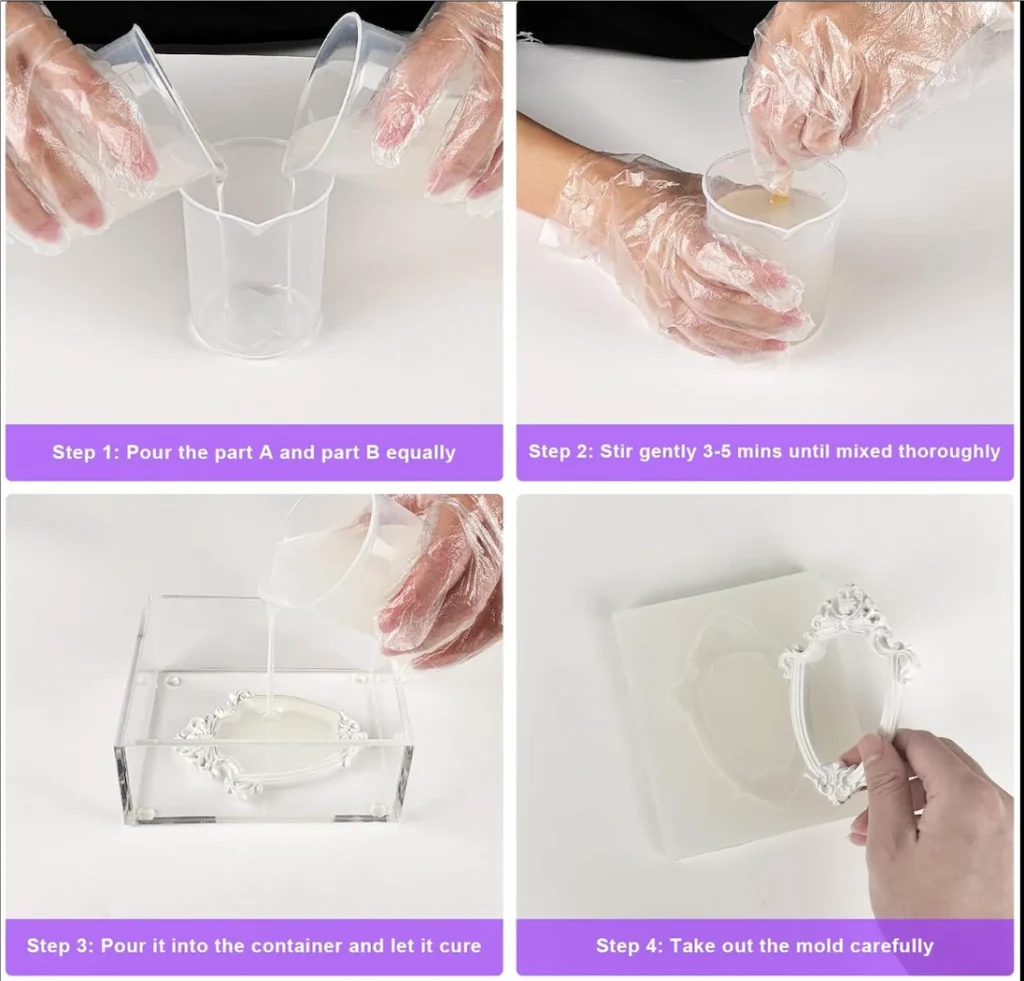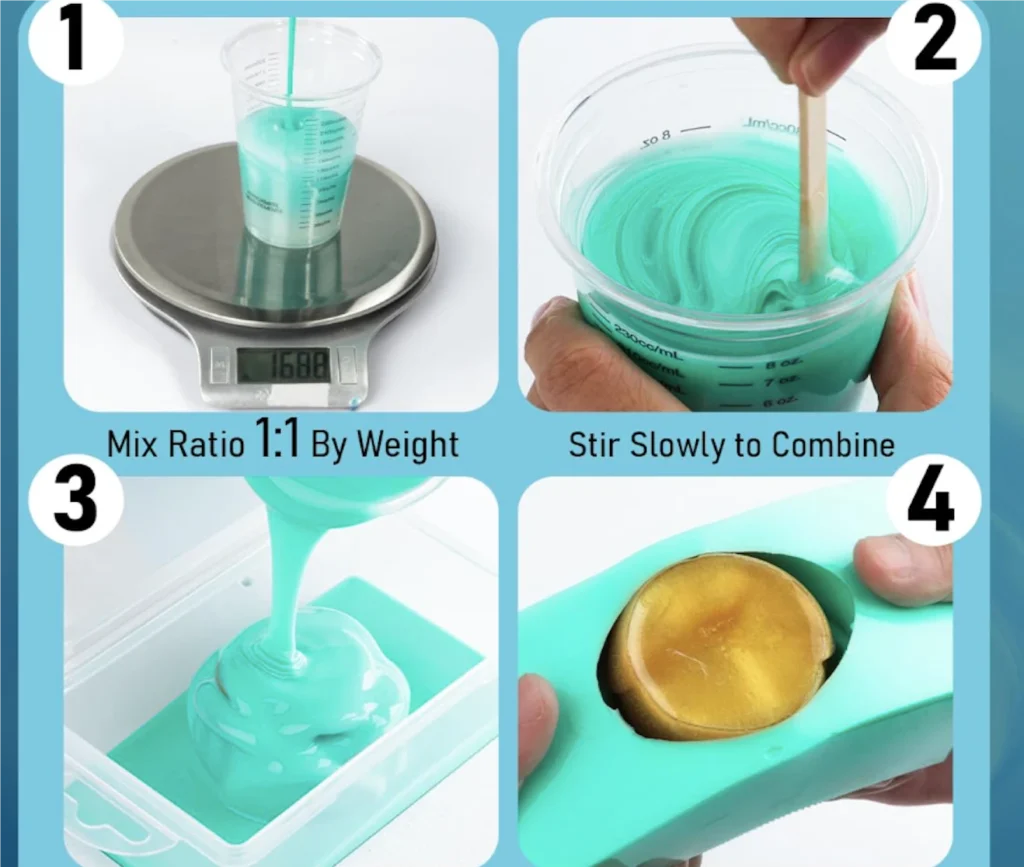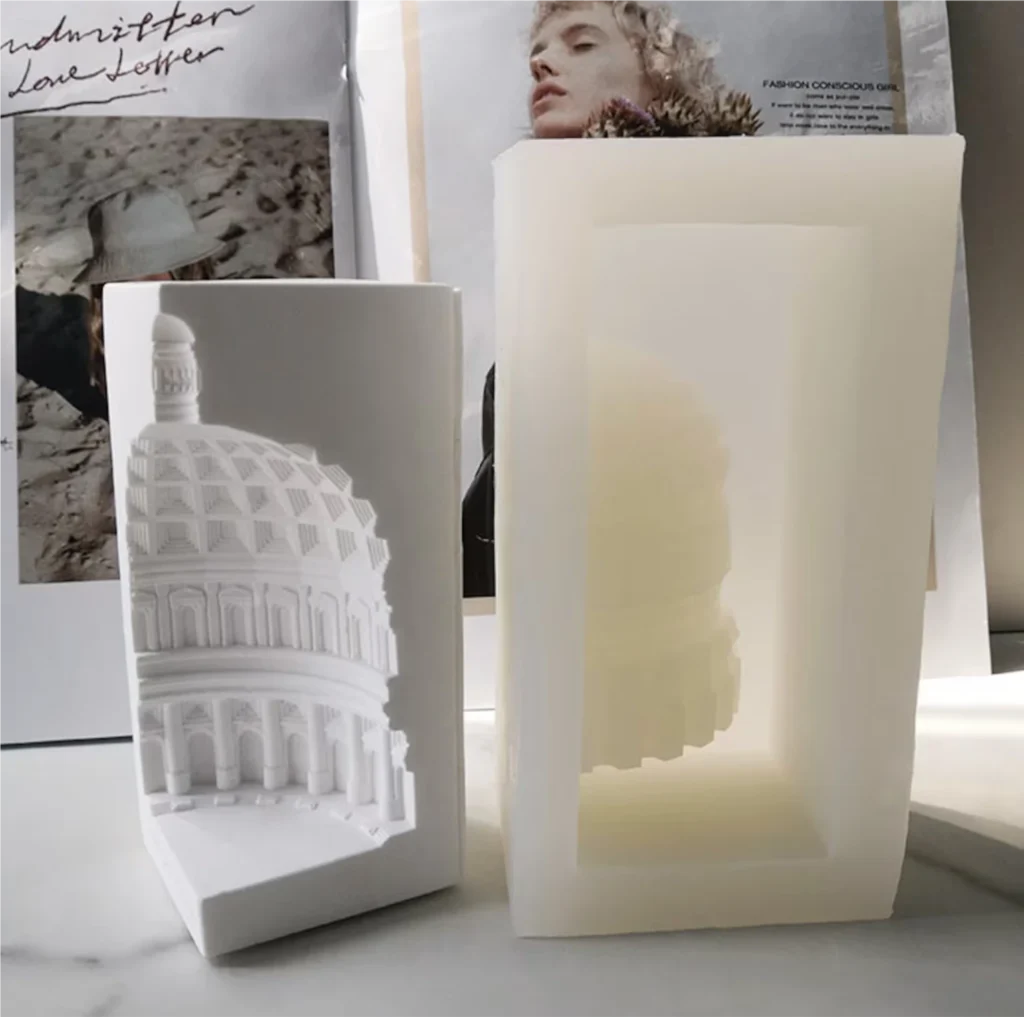Hello! Do you like to make things? Maybe you make toys, art, or molds? Molds help you make the same shape many times. Silicone is a great stuff for making molds. It is soft and bendy.
But wait! There are two main kinds of silicone for molds. One is called Tin Silicone. The other is called Platinum Silicone.
They look alike sometimes. But they are very different! It is like having two types of play-dough. One might be better for some toys, and the other is better for different toys.
This article will help you know the difference. We will look at tin silicone vs platinum silicone. We want to help you choose the best one for your cool project!
What Are These Silicones? Let’s Learn!
Think of silicone like cake batter. It starts as a liquid. Then, it gets hard.
Tin Silicone: This type uses tin to help it get hard. Think of tin like a helper friend. It is also called condensation cure silicone . This name means it needs water from the air to work. Many artists and people starting out like this one. It is often called RTV silicone, which means Room Temperature Vulcanizing – it gets hard just sitting in the room! This uses a tin catalyst. A catalyst is like a magic key that starts the hardening. Tin-based condensation silicone is a common name for it. Topsil silicone T-25 is one example of this kind . It has good flow so it fills up tiny spaces in your model . It also has a low Shore A hardness, which means it’s quite soft and stretchy. This makes it good for molds with tricky shapes, called undercuts .
Platinum Silicone: This type uses platinum to help it get hard. Platinum is a special, shiny metal. It is also called addition cure silicone. This name means two parts mix together to make it hard. It does not need air water. This also uses a catalyst, a platinum catalyst. A platinum catalyst makes the liquid silicone turn solid. These are often very pure and clean. Sometimes you hear about Liquid Silicone Rubber (LSR) – platinum silicone is often an LSR type.
The big chemical difference is the metal helper: tin or platinum 2. This changes how they work!

How Do They Get Hard? The Curing Magic!
“Curing” just means getting hard. Like baking a cake makes the batter solid.
Tin Silicone Curing (Condensation Cure Process):
This needs water from the air (humidity). Like a plant needs water to grow!
The tin catalyst helps the silicone parts link together. This linking is called crosslinking in silicone polymers.
It makes a tiny bit of alcohol as it cures. Sometimes you can smell an odor in tin-cured silicone.
- The tin condensation cure process happens at room temperature 1. You mix it, pour it, and wait!
Platinum Silicone Curing (Platinum Addition Cure Process):
- This needs two parts mixed just right. Like mixing blue and yellow paint to get green.
- The platinum catalyst helps the parts join up perfectly. This joining is called hydrosilylation reaction.
- It does not make anything extra as it cures. No smell!
- It can cure at room temperature. But! You can use heat to make it cure super fast! If you warm it up, it gets hard much quicker . This is called heat accelerated curing . Sometimes there is a little exotherm in curing, meaning it gets slightly warm on its own.
So, the silicone curing methods are different. One uses air water (tin), the other uses mixing and maybe heat (platinum).
Condensation vs addition curing is a key difference!
How Are They Different in Using Them? (Performance)
Okay, they get hard differently. How else are they different? Let’s make a list!
How Much They Cost:
- Tin silicone is usually cheaper . The tin catalyst costs less than platinum . Good if you don’t have much money for your project . Or if you are just learning silicone mold making. Tin silicone for prototypes is popular because it’s affordable.
- Platinum silicone costs more . Platinum is a rare metal, like gold. So, the platinum catalyst cost factors make it pricier.
Is It Safe? (Toxicity):
- Tin silicone can have stuff in it that is not safe to touch skin a lot or use for food molds . The tin-based silicone toxicity means you should work in a place with fresh air . Always read the safety paper, called an SDS Safety data sheet . It might have tin byproduct concerns.
- Platinum silicone is usually very safe . It is often non-toxic . This makes it great if your mold touches skin or food. Platinum catalyst silicone safety is high. It has good biocompatibility, meaning it is friendly to living bodies. You can find skin-safe silicone materials made this way. This is a big reason people choose it for things like baking mold silicone safety.
How Fast They Cure:
- Tin silicone cures at its own speed. Usually takes about a day (24 hours).
- Platinum silicone can cure in hours. And with heat, maybe even minutes! So, the silicone curing time comparison favors platinum if you are in a hurry.
Things That Stop Curing (Inhibition):
- Tin silicone is usually easygoing. It will cure okay on most things . It’s forgiving .
- Platinum silicone can be picky! Some things stop it from curing. This is called cure inhibition or platinum catalyst poisoning. Things like sulfur (in some clays), tin (yes, tin!), latex rubber, and some 3D printed plastics can stop it. You need a very clean model. Sometimes platinum-based inhibitors are used on purpose to slow curing.
How Long They Last (Shelf Life):
- Unopened tin silicone might last 6 months to a year.
- Unopened platinum silicone often lasts longer, maybe over a year. Check the date! Silicone shelf life analysis is important.
How Hard or Soft They Are:
- Both kinds come in different softness levels. This is measured by Shore hardness scales (A/D) . Lower numbers (like Shore A 25 for Topsil Silicone T-25) mean softer, stretchier silicone . Higher numbers mean firmer silicone. You pick based on your mold needs. Silicone hardness comparison depends on the specific product, not just tin vs platinum.
Shrinking:
- Tin silicone can shrink a tiny bit over time as it fully cures and releases byproducts . This is one of the tin silicone shrinkage issues.
- Platinum silicone shrinks very, very little. Almost none! Tin vs platinum shrinkage rates show platinum is more stable.
Here is a simple table based on our research findings :
| Feature | Tin Silicone | Platinum Silicone | Why It Matters |
| Helper | Uses Tin catalyst | Uses Platinum catalyst | Changes cost, safety, and how it works. |
| Safety | Be careful, may not be skin/food safe | Often very safe, even for food/skin | Choose platinum for safe things! |
| Cost | Cheaper | Costs more | Tin is good for low budgets. |
| Curing Speed | Slower (about a day) | Faster, can speed up with heat | Platinum is fast if you need it quick. |
| Picky Curing? | No, usually cures well | Yes, some things stop it from curing | Be careful what your model is made of for platinum. |
| Shrinking | Shrinks a little | Shrinks almost not at all | Platinum keeps its shape better. |
| Best For | Art, practice molds, industrial molds | Food, skin, medical, long-lasting molds | Matches the right silicone to the right job. |

What Should I Use Them For? Best Jobs for Each!
Okay, let’s list some jobs!
Use Tin Silicone For:
- Art molds: Making statues or shapes for fun.
- Making prototypes: Trying out a new design cheaply.
- Industrial silicone applications: Molds for things not used with food or skin. Like making parts for machines. Tin silicone for industrial molds is common.
- Construction: Some silicone sealant types use tin cure. Tin silicone for construction is used sometimes.
- Home crafts: Fun projects where super safety or long life is not the top need. Check out ideas for Silicone for Home Crafts & Hobbies Mold Making.
- Reproducing models, especially with tricky shapes, using resins like polyester 1. ELASTOSIL® M 4503 is good for this 1.
- Casting plaster or wax 1.
Use Platinum Silicone For:
- Food molds: Making candy, ice cubes, or baking mold silicone safety. Meets food-grade silicone requirements. Look for FDA-approved silicone materials or food-safe silicone certifications like FDA 21 CFR §177.2600.
- Medical stuff: Making things that touch the body. Meets medical-grade silicone standards. Used for prosthetics manufacturing and implantable devices. It needs special ISO 10993 biocompatibility testing. Platinum silicone biocompatibility is key here. Implant-grade silicone requirements are very strict.
- Skin molds: Making masks or fake wounds for movies (cosmetic applications (SFX)) or prosthetics. Skin-safe silicone materials are platinum cure. Meets skin contact safety standards.
- Baby items: Like bottle nipples or pacifiers. Must be non-toxic!
- Long-lasting molds: Molds you want to use many, many times. Reusable silicone products often use platinum. Reusability of silicone molds is better with platinum.
- High-temperature silicone molds: For casting metals with low melting points or baking. Has good heat resistance of platinum silicone. Check thermal degradation temperatures.
- Electronics: Protecting tiny parts inside computers or phones (electronics encapsulation, potting and encapsulation silicones). Platinum silicone for electronics is chosen for purity and dielectric properties comparison (how well it stops electricity).
- Dentistry: Platinum silicone for dentistry is used for making teeth molds.
- Automotive silicone applications: Like gaskets that need to resist heat. Automotive gaskets need good thermal stability.
- Aerospace silicone requirements: Used in planes and rockets! Needs to be super reliable. Aerospace sealants demand high performance.
- Making silicone for candle mold making, especially if you want a long-lasting mold. Find options for Silicone for Candle Mold Making.
Which One Lasts Longer? (Durability)
Durability means how tough something is and how long it lasts.
Platinum silicone is the winner here!
- It has great durability over time.
- It resists heat very well (heat resistance of platinum silicone).
- It does not break down easily from chemicals (platinum silicone chemical resistance, chemical stability of platinum silicone).
- It does not yellow or get weak in sunlight (UV resistance in silicones, platinum silicone color stability).
- It stays flexible (flexibility of platinum silicone).
- It has good aging resistance in silicones.
- It has strong platinum silicone tensile strength (how much you can pull it before it breaks). Scientists use tests like ASTM D412 to measure this. Tensile modulus is another measure of stiffness.
- It resists tearing well (great extensibility and elasticity 1).
Tin silicone is good, but not usually as tough as platinum.
- It can shrink a little over months or years .
- It might get brittle or sticky faster, especially if hot or wet. It has lower hydrolysis resistance comparison.
- Its longevity is generally less than platinum.
- Silicone degradation factors affect tin cure more quickly.
So, if you need a mold to last a very long time and stay perfect, longevity of platinum silicone makes it a better choice.

Safety First! Which is Safer?
We talked about this, but it’s super important!
Platinum Silicone = Safest
- Usually non-toxic .
- Often meets FDA rules for food . Look for FDA 21 CFR §177.2600.
- Often meets ISO 10993 rules for medical use (biocompatibility testing).
- Good for skin contact (skin contact safety standards, allergen-free silicone options). No skin irritation tests failures usually.
- Low VOC emissions in curing (less smelly fumes).
- Many eco-friendly silicone options are platinum-based.
Tin Silicone = Use Carefully
- Uses tin octoate (stannous octoate) or similar tin catalysts which can be toxic .
- Not usually for food or long skin contact .
- May release alcohol or other VOC emissions when curing. Use in a place with good air flow .
- Read the SDS Safety data sheet !
Always check the label! Look for words like “food safe“, “skin safe“, or “medical grade“. These usually mean it is a platinum silicone. Companies like Smooth-On, Dow Corning (now Dow), Topsil Silicone, Wacker Chemie AG , and Shin-Etsu Silicones make both types. Check their technical data sheet (TDS) and safety info.
Quick Questions Answered (FAQs)
- Which silicone is better for food molds?
- Platinum silicone is the one you want! It is safe for food .
- Can I use tin silicone for a skin mold?
- No, it is usually not safe for skin . Use platinum silicone labeled “skin safe”.
- Why is platinum silicone more expensive?
- The platinum catalyst metal is rare and costs more .
- Which one is easier for beginners?
- Tin silicone can be easier because it is less picky about what it touches . But platinum silicone is safer if you are making things for skin or food .
- Does tin silicone smell bad?
- It can have a slight alcohol smell when curing. Platinum usually has no smell.
- Which one lasts longer?
- Platinum silicone molds usually last much longer .
How Do I Choose the Right One?
Think about your project! Ask yourself:
- What am I making a mold of?
- If it touches food, skin, or goes inside the body, use Platinum Silicone. Safety first!
- How much money can I spend?
- If your budget is tight and safety is not for food/skin, Tin Silicone might work .
- How long do I need the mold to last?
- For a super strong, long-lasting mold, use Platinum Silicone .
- Am I in a hurry?
- If you need it done fast, Platinum Silicone can cure quicker with heat .
- What is my original model made of?
- If your model has sulfur clay or latex, Tin Silicone might be safer . Platinum Silicone might not cure! Avoid catalyst poisoning (sulfur/nitrogen).
You might see different silicone rubber grades. Some are thin (low-viscosity silicones) and flow easily. Some are thick like paste (High-consistency rubber (HCR)). Some are made for special ways of making things, like compression molding silicones or injection molding silicones or silicone extrusion processes.
Look at the PDMS (Polydimethylsiloxane) base properties, which is the main part of most silicones. The siloxane backbone structure is key. Consider electrical insulation properties or dielectric properties comparison if making electronics (platinum silicone for electronics). Think about thermal conductivity differences if heat is involved. Maybe you need flame retardant silicones.
For big projects like making copies of furniture parts, you need strong, reliable silicone. Platinum might be better for detail and long life, though tin is often used for cost. See info on Silicone for Furniture Mold Making.
Sometimes you need mold release agents for silicone, especially if casting silicone into a silicone mold.
Think about the end! Silicone recycling challenges exist, so try to make molds last.
In short:
- Cheap & Easy (non-food/skin): Tin Silicone
- Safe & Long Lasting: Platinum Silicone
Now you know the big difference between tin and platinum silicone! You can pick the best one for your amazing creations. Happy making!